

|
| ČESKÁ REPUBLIKA | CZECH REPUBLIC |
| Středočeský kraj | Central Bohemia region |
| Okres: Kutná Hora |
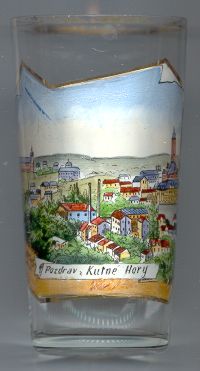
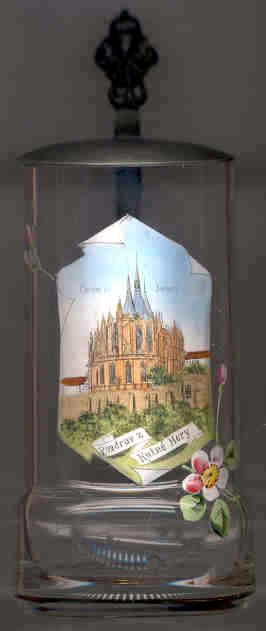 The district town Kutná Hora is situated at an elevation of 273 m on the Vrchlice stream in eastern Central Bohemia.
Mining for silver began in 1280 and for centuries shaped the history of the town.
During the Middle Ages, Kutná Hora (in German: Kuttenberg) was the largest town of Bohemia and repeatedly was
the residence of the Bohemian Kings and the site of royal diets.
In 1409, King Wencelav (Václáv, Wenzel) IV issued the Kuttenberg Decree, which resulted in the emigration of German
professors and students from the university of Prague and the subsequent foundation of the
university of Leipzig.
In 1421–1424, Kutná Hora was captured by the Hussites, recaptured by Emperor Sigismund, and captured again and burned by Jan
Žižka. Until then a stronghold of Catholicism, it became for two centuries the center of Bohemian Protestantism. The diet of 1485
seeked a compromise between the religious parties in Bohemia. The first printers began to work in Kuttenberg in 1488. Their most famous work is
the Kuttenberg Bible of 1489. The city suffered again in the Thirty Years' War (1618–1648) and lost its importance after the silver mines
closed in the 17th century. The historical town centre with the church of St. Barbara and the Cathedral of Our Lady at
Sedlec (Sedletz, today part of Kutná Hora) were listed as a World Cultural Heritage by the UNESCO in 1995 (see also
list of other UNESCO heritage sites).
The district town Kutná Hora is situated at an elevation of 273 m on the Vrchlice stream in eastern Central Bohemia.
Mining for silver began in 1280 and for centuries shaped the history of the town.
During the Middle Ages, Kutná Hora (in German: Kuttenberg) was the largest town of Bohemia and repeatedly was
the residence of the Bohemian Kings and the site of royal diets.
In 1409, King Wencelav (Václáv, Wenzel) IV issued the Kuttenberg Decree, which resulted in the emigration of German
professors and students from the university of Prague and the subsequent foundation of the
university of Leipzig.
In 1421–1424, Kutná Hora was captured by the Hussites, recaptured by Emperor Sigismund, and captured again and burned by Jan
Žižka. Until then a stronghold of Catholicism, it became for two centuries the center of Bohemian Protestantism. The diet of 1485
seeked a compromise between the religious parties in Bohemia. The first printers began to work in Kuttenberg in 1488. Their most famous work is
the Kuttenberg Bible of 1489. The city suffered again in the Thirty Years' War (1618–1648) and lost its importance after the silver mines
closed in the 17th century. The historical town centre with the church of St. Barbara and the Cathedral of Our Lady at
Sedlec (Sedletz, today part of Kutná Hora) were listed as a World Cultural Heritage by the UNESCO in 1995 (see also
list of other UNESCO heritage sites).
The famous  church of St. Barbara (chrám sv. Panny Barbory) [right and below]
is a masterpiece of Late-Gothic architecture. The church was begun by Peter and Johann Parler in 1388, their followers
Matthias Rejsek and Benedikt Ried (Rejt) continued the construction. The church was completed in 1558.
After 1626, the church belonged to the Jesuits. In 1905 the cathedral was newly consecrated and since then belongs to
the parish and archdecanal office attached to St. James church at Kutná Hora.
church of St. Barbara (chrám sv. Panny Barbory) [right and below]
is a masterpiece of Late-Gothic architecture. The church was begun by Peter and Johann Parler in 1388, their followers
Matthias Rejsek and Benedikt Ried (Rejt) continued the construction. The church was completed in 1558.
After 1626, the church belonged to the Jesuits. In 1905 the cathedral was newly consecrated and since then belongs to
the parish and archdecanal office attached to St. James church at Kutná Hora.
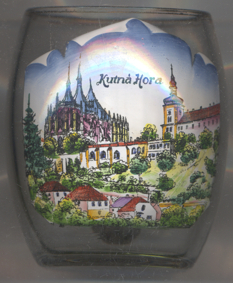
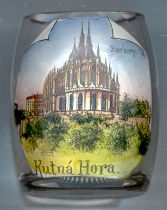
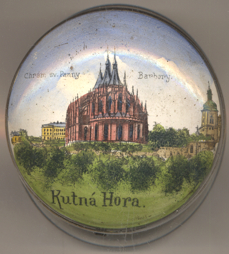
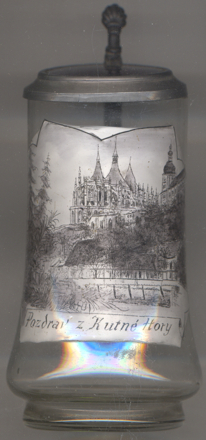
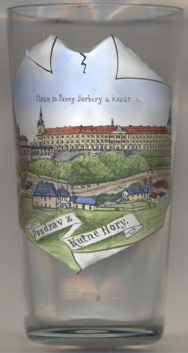
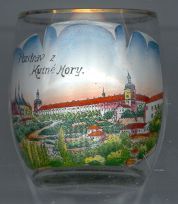
The  Jesuit college (Jezuitská kolej) [left, no. 3912, and right,
no. 1728] was built in 1667–1700 by the architect Domenico Orsi. The Baroque building was erected on
an F-shaped ground plan to honour Emperor Ferdinand II. The Jesuits had been called into Kutná Hora in 1626
to re-catholicize the then Utraquist town and its surroundings.
Jesuit college (Jezuitská kolej) [left, no. 3912, and right,
no. 1728] was built in 1667–1700 by the architect Domenico Orsi. The Baroque building was erected on
an F-shaped ground plan to honour Emperor Ferdinand II. The Jesuits had been called into Kutná Hora in 1626
to re-catholicize the then Utraquist town and its surroundings.
The building depicted in the bottom foreground of glass no.8239;3912 [left] are identified
on the glass as  barracks
barracks
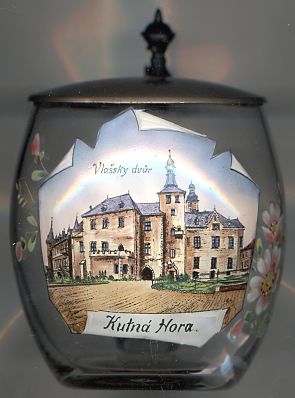
The  Italian Court (Vlašský dvůr) (German: Welscher Hof)
[near left, no. 2351, and below, no. 4254: top right picture]
was built in the second half of the 13th century as a mint of the Prague Groschen.
In the 14th century it was the central mint of the kingdom of Bohemia. Towards the end of the century, the castle was
remodeled to become a royal residence. When the mint was moved away in 1724, the castle began to fall into dereliction.
The structure was restored only at the end of the 19th century. In 1904, the royal chapel, originally from the Gothic period,
was remodeled in Art Nouveau style by František and Marie Urban.
Italian Court (Vlašský dvůr) (German: Welscher Hof)
[near left, no. 2351, and below, no. 4254: top right picture]
was built in the second half of the 13th century as a mint of the Prague Groschen.
In the 14th century it was the central mint of the kingdom of Bohemia. Towards the end of the century, the castle was
remodeled to become a royal residence. When the mint was moved away in 1724, the castle began to fall into dereliction.
The structure was restored only at the end of the 19th century. In 1904, the royal chapel, originally from the Gothic period,
was remodeled in Art Nouveau style by František and Marie Urban.
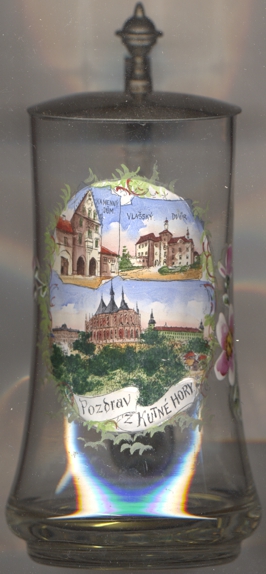
The Gothic  Stone House was built already before the Hussites conquered the town. It obtained its present
look with its magnificent masonry in 1489. The municipality acquired the house at the end of the 19th century. Since 1902 it serves
as a museum of silver. It also contains one of the richest archives in the country.
Stone House was built already before the Hussites conquered the town. It obtained its present
look with its magnificent masonry in 1489. The municipality acquired the house at the end of the 19th century. Since 1902 it serves
as a museum of silver. It also contains one of the richest archives in the country.
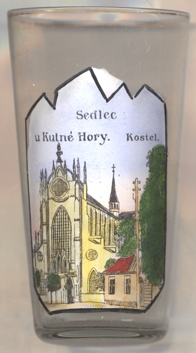 Sedlec Abbey was founded in 1142 as the first Cistercian monastery in Bohemia by monks from the abbey of Waldsassen.
The monastery soon flourished due to silver mining in the region. The abbey was originally built in Romanesque style. The abbey church was dedicated
to the Assumption of Mary and St. John the Baptist. It was remodeled in Gothic style as a basilica with five naves between 1280 and 1330.
The abbey was burnt in April 1421 by the Hussites and many monks were killed. The library had been secured shortly before to the abbey of
Klosterneuburg in Lower Austria. A few monks returned, but it took until after the Thirty Years' War (1618–1648)
when in 1620 the monastery was revived. The abbey was rebuilt from 1699 to 1707 after designs by Paul Ignaz Bayer and Jan Santini Aichel.
Another restoration, trying to preserve the original appearance, was performed from 1854 to 1857. Along with the rest of the Kutná Hora town centre,
the entire abbey was listed as a UNESCO World Heritage Site in 1995 (see also list of other UNESCO heritage sites).
Sedlec Abbey was founded in 1142 as the first Cistercian monastery in Bohemia by monks from the abbey of Waldsassen.
The monastery soon flourished due to silver mining in the region. The abbey was originally built in Romanesque style. The abbey church was dedicated
to the Assumption of Mary and St. John the Baptist. It was remodeled in Gothic style as a basilica with five naves between 1280 and 1330.
The abbey was burnt in April 1421 by the Hussites and many monks were killed. The library had been secured shortly before to the abbey of
Klosterneuburg in Lower Austria. A few monks returned, but it took until after the Thirty Years' War (1618–1648)
when in 1620 the monastery was revived. The abbey was rebuilt from 1699 to 1707 after designs by Paul Ignaz Bayer and Jan Santini Aichel.
Another restoration, trying to preserve the original appearance, was performed from 1854 to 1857. Along with the rest of the Kutná Hora town centre,
the entire abbey was listed as a UNESCO World Heritage Site in 1995 (see also list of other UNESCO heritage sites).
[https://de.wikipedia.org/wiki/Kutn%C3%A1_Hora, https://en.wikipedia.org/wiki/Kutn%C3%A1_Hora;
https://en.wikipedia.org/wiki/Sedlec_Abbey]
![[scale]](lineal.jpg)